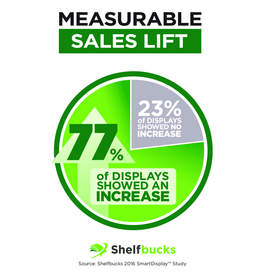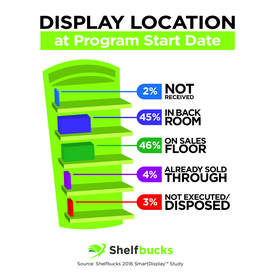AUSTIN, TX--(Marketwired - Jan 16, 2017) - For the first time in retail history, a dozen of the country's largest consumer packaged goods (CPG) companies launched technology-enabled, in-store merchandising display campaigns that provided daily performance data and alerts, proving increased product sales and identifying significant new sales opportunities.
The 27 independent campaigns, enabled by the Shelfbucks SmartDisplay™ merchandising platform, generated more than 20 million data points and detailed observations every day and night from point-of-purchase (POP) displays throughout every store's selling areas and stock rooms. This unprecedented data precision, combined with daily sales and other rich datasets, yielded original and empirical insights about merchandising performance and the many factors impacting those results, such as merchandising supply chain, display arrival and set-up timing, sales floor execution and product sales lift.
Shelfbucks' analysis of campaigns found that approximately 77 percent of promotional displays drive measurable incremental sales increases at retail. Through analysis of these programs, Shelfbucks also identified improvement opportunities for retailers and brands that could increase incremental sales from displays by an additional 30 to 45 percent, yielding the industry tens-of-millions of dollars in incremental promotional sales, at scale.
Twelve CPG manufacturers launched Shelfbucks-enabled campaigns, including Procter & Gamble, Unilever, The Kraft Heinz Company, Mondelēz International, and Duracell. The campaigns incorporated 21 different consumer brands and were executed across two major retail channels, including grocery, and with three leading national retailers. Participating brands included well known products Covergirl, Oreo, Dove, Simple, Vaseline, Duracell, Kraft Mac & Cheese and Flonase.
The campaigns were applied to eight different POP display types, including end caps, floor stands, trays, power wings, side wings and shelf extenders. In building its promotional merchandising ecosystems, Shelfbucks has partnered with nine leading POP display manufacturers, six of which participated in these initial campaigns.
"Historical processes for evaluating the performance of in-store merchandising campaigns have been complicated and lacking in the qualitative data one might find for other marketing vehicles," said Jill Andersen, director of marketing for Menasha, one of six POP display manufacturers that participated in the campaigns. "And the time required for those analyses made them insufficiently actionable. Our customers' Shelfbucks-enabled campaigns have shown that we can now gather performance data in real time to not only measure performance, but also identify how we can quickly, for example, adjust in-store placement to optimize our use of floor space for even greater customer interaction and sales results."
Erik McMillan, CEO of Shelfbucks added: "The actionable data we've gathered through these first campaigns are industry changing, whether we are confirming marketing successes or identifying execution missteps that contributed to campaigns underperforming. We can now, for example, identify and overcome logistics timing issues across the merchandising supply chain that have long plagued both brands and retail operators. Some displays arrive early to distribution centers and subsequently arrive in stores many weeks before a scheduled promotion. This can result in 20 percent of stores selling out of the display before the peak promotion. Other merchandising campaigns don't get placed on-floor until well after the peak promotional period. Both scenarios result in loss of sales, inventory imbalance and shopper frustration. Shelfbucks-enabled campaigns can now measure, adjust and overcome these challenges."
CPG and retail customers incorporate the Shelfbucks platform into POP merchandising programs, enabling continuous, daily reporting on when and where displays are installed within retail stores. Shelfbucks provides detailed insights on performance against marketing and sales goals, enabling brands to optimize their campaigns to maximize sales. Shoppers browsing a product area can also easily interact with Shelfbucks-enabled merchandising materials using their smartphones to immediately access product content, promotional offers, ratings and reviews, and other relevant product or category information.
Shelfbucks is continuing to partner with these and other brands, retailers and POP display manufacturers to for a wide range of additional SmartDisplay campaigns throughout 2017.
About Shelfbucks
Shelfbucks is the number-one in-store merchandising optimization and mobile media platform, enabling retail and CPG brand customers to realize additional revenue and brand equity from in-store marketing programs with insights that lead to better merchandising decisions, and new personalized shopper experiences that lead to increased sales per visit. Additional information on Shelfbucks is available at www.shelfbucks.com. Watch industry leaders speak on digital coming to the in-store experience at www.shelfbucks.com/insights. SmartShelf™ and SmartDisplay™ are trademarks of Shelfbucks Inc.
Contact Information:
Contact:
Scott Phillips
Scott Phillips + Associates, Inc.
sphillips@sphillips.com
312.943.9100 x28
312.813.0771 (at NRF)

